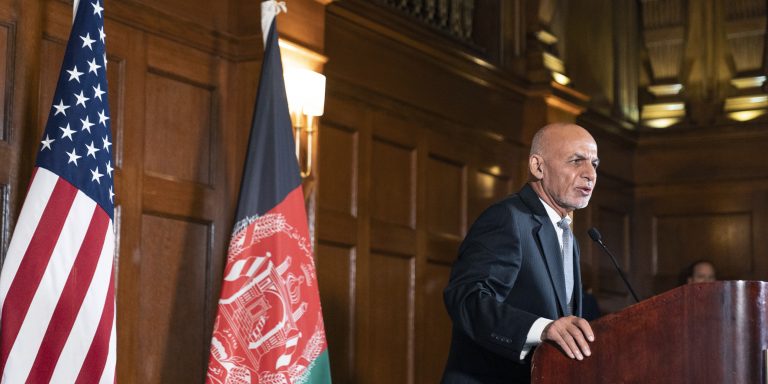INTELBRIEF
July 2, 2021
IntelBrief: Afghanistan Continues to Descend into Violence with No End in Sight

Bottom Line Up Front
- While the Taliban has long followed a “fight-and-talk” approach, in early July 2021, there is a lot of fighting and not much talking in Afghanistan.
- Recent assessments by the U.S. intelligence community concluded that the Afghan government could collapse within the next six months.
- Entire districts and cities are being threatened by the Taliban’s military offensive, resulting in the insurgents capturing American-supplied material.
- The worsening security situation has prompted a mobilization to armed militias and led many to worry once again about a return to all-out civil war.
United States President Joseph Biden met with President Ashraf Ghani of Afghanistan last week to discuss recent setbacks in Afghanistan. U.S. Secretary of State Antony Blinken commented last week that Washington was assessing whether the Taliban was serious about the peace process, a concept that might seem absurd considering the uptick in insurgent activity since President Biden announced his intentions to withdraw U.S. troops in mid-April. While the Taliban has long followed a “fight-and-talk” approach, in early July 2021, there is a lot of fighting and not much talking. Moreover, actions speak louder than words, and the Taliban’s military offensives seem to indicate little interest in a power-sharing agreement with the Afghan government. The Taliban remain confident, Afghan forces are on the defensive, and the U.S. is racing for the exits. Meanwhile, regional powers are angling to secure their respective national interests, cutting deals with various powerbrokers, and jockeying for position, and the very communities the US purported to protect remain more vulnerable than ever.
Recent assessments by the U.S. intelligence community have concluded that the Afghan government could collapse within the next six months, following the withdrawal of U.S. troops. Others believe the collapse could come even sooner. General Austin Miller, commander of U.S.-led forces, recently noted that “civil war is certainly a path that can be visualized.” Over the past several weeks, Taliban fighters have overrun parts of northern Afghanistan, gaining control over a third of the country as Afghan security forces have been unable to hold their ground in the face of the militants’ onslaught. There is looming uncertainty surrounding the future of U.S. air support to Afghan forces engaged in heavy fighting, which continues to take a toll on the population. Deborah Lyons, the United Nation’s top envoy for Afghanistan, has repeatedly voiced concerns about an imminent crisis, noting a twenty-nine percent increase in civilian casualties over the first several months of this year, including a rise in casualties among women and children, and a negative trajectory on key trends relating to politics, security, the peace process, the economy, the humanitarian emergency, and COVID. Civilians have borne the brunt of the fighting and misery, which has been compounded by Afghanistan’s continued struggles in dealing with the COVID-19 pandemic.
Fighting has raged in Kunduz, Afghanistan’s sixth-largest city on the country’s northeastern border with Tajikistan. Entire districts and cities are being threatened by the Taliban’s military offensive, which in some cases has resulted in the insurgents capturing American-supplied vehicles and equipment from Afghan forces. There were several reports of Afghan forces simply abandoning their positions and surrendering weapons to the Taliban in exchange for free passage. The scenes are already eerily reminiscent of what played out in parts of Iraq in the early stages of the rise of the so-called Islamic State. That scenario could very well repeat itself in Afghanistan, providing transnational terrorist groups like al-Qaeda and the Islamic State Khorasan Province (ISKP) with the momentum necessary to rebuild their respective operational and organizational capabilities and capitalize on regional discontent and grievances. As U.S. military planners prepare for the possibility of having to evacuate U.S. personnel should the situation deteriorate rapidly, the other comparison many are making is to Saigon in 1975, when U.S. forces left Vietnam.
The worsening security situation has prompted a mobilization of armed militias and increased warlord activity, leading many Afghans and observers to worry once again about a return to all-out civil war. The country has been continuously plagued by violence and conflict for the past four decades. ISKP’s brutal sectarian agenda is designed to further fuel the potential for civil war, modeled after al-Qaeda’s terror campaign in Iraq in the mid-2000s, led by jihadist Abu Musab al-Zarqawi. Over the course of the past two months, the Taliban have captured dozens of district capitals and there is speculation that its fighters are waiting until the U.S. troop withdrawal is complete before advancing in earnest on major cities, like Kandahar. In a shakeup designed to improve morale, the Afghan government recently appointed a new acting minister of defense, minister of interior and army chief. When coupled with battlefield setbacks and soldiers who have gone unpaid for months, the signs are ominous. Without American and NATO military support to the Afghan government and security forces, many fear a complete Taliban military takeover of the country by year’s end.